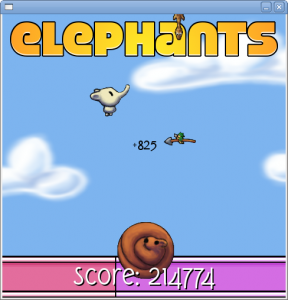Dynamite Jack: The second prototype, post-post mortem
Monday, April 23rd, 2012So about six months after I created “Escape from Anathema Mines” during the Ludum Dare game jam, I created a game called Dynamite in the PyWeek game jam.
Theme
So the theme of PyWeek #1 was “Power” .. I worked with my brother-in-law Tim on this game, and we spent a fair amount of time working with the idea of using a “mind control power” over the characters in game. So I wrote some A* code to navigate things around and whatnot. This was boring. So I made it so you could blow something up. This was exciting. We decided “the power of dynamite” was what the game was about, since the dictionary definition of dynamite said something about “a powerful explosive.” Not my best “theme compliance” for a game jam, I’ll admit.
Gameplay
The best way to see the gameplay is to PLAY THE GAME if you have Windows 🙂 (Download the post-compo version, it’s a little shinier.) But short of that, watch me play through one of the levels. There’s a ton of interesting differences between this and Dynamite Jack. The most significant one is that in Dynamite you can “fail” really easily. You can block yourself into a corner by destroying the floor, and you can run out of bombs. Those are both design decisions I changed for Dynamite Jack.
Fun facts
Tim created all the music for this game, one of the tracks is based on a fiddle tune as well. You may be able to tell that the character art in this game is the same character art I ended up using in Dynamite Jack. It’s all from Reiner’s Tilesets. It definitely helped a ton to have that art work. It ends up looking really sharp in Dynamite Jack because I scale things down so small.
I also brought the “dynamite drop” sound effect from this game into Dynamite Jack. It just sounds so cool.
Post-Mortem
I think one of the big gameplay mechanics I like in that game is that when you sneak along the walls you are invisible to the guards. It kinda leaves the “lighting effects” to your imagination. But one of the problems with that is that it’s not very obvious. I used the different colored cursor to help the player be able to know where the safe zones were.
This game introduced the fun of having guards running to check out whatever you just exploded. I did the voice acting in this prototype of the game.
The idea of this game really stuck with me for a long time, so for the next several years I always talked about going back and re-making it.
TO BE CONTINUED …
(Dynamite Jack is coming to PC / Mac in mid-May. Check out the trailer to see the difference from the original shown here.)





 I’ve spent the last week working on a tinypy to C++ converter. It works! See the screenshot to the right – I’ve managed to port a pygame game over to C++.
I’ve spent the last week working on a tinypy to C++ converter. It works! See the screenshot to the right – I’ve managed to port a pygame game over to C++.



